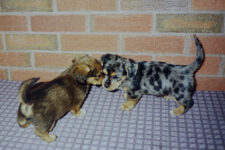The Independent Beagle – happy, loving and outgoing
 The Independent Beagle is a hound, a scenthound to be exact. This gives you a pretty good idea what he loves to do best, unless he isn’t true to breed and a few aren’t.
The Independent Beagle is a hound, a scenthound to be exact. This gives you a pretty good idea what he loves to do best, unless he isn’t true to breed and a few aren’t.
He’s got the looks!
He’s a lovely looking dog with appealing dark brown/hazel eyes which have a soft earnest expression. This is a happy, loving and affectionate dog balanced by its hound traits of inquisitiveness, determination and focus, much of the focus being on food and scents.
Unusual vocals
Although he is not a bark dog as such, he has some unusual vocalisations. The most disconcerting to some owners and those that do not know the breed, is the baying howl mixed with a frenzied bark. Many may think the dog is being strangled or mis-treated. But no, this is a conversation which says either “I’ve found it, I can smell it, I can see it!” or perhaps all three!
Very friendly
They are usually a friendly dog, getting on well with other canines, afterall they are pack dogs as are Foxhounds. They were first used for hare or rabbit hunting. Today, they are often companion dogs, occassionally gundogs and used in field trials.
Scenthounds
 One of the other uses these scenthounds are put to, are seeking out contraband such as food, tobacco and drugs being illegally imported. Many airport and border crossings will have ‘sniffer dogs’ with this particular breed being popular because it is small, friendly and not intimidating for the public. They often patrol the baggage claim areas where suspect luggage can be pinpointed before being picked up by the potential smuggler.
One of the other uses these scenthounds are put to, are seeking out contraband such as food, tobacco and drugs being illegally imported. Many airport and border crossings will have ‘sniffer dogs’ with this particular breed being popular because it is small, friendly and not intimidating for the public. They often patrol the baggage claim areas where suspect luggage can be pinpointed before being picked up by the potential smuggler.
Housetraining
It is said that Beagles can be difficult to housetrain with some complaining that it can take a year to fully house train some. This opinion seems to be applied to many breeds, including Yorkshire Terrier, Pomeranians, Maltese Terrier, Pugs, Cocker Spaniels etc..
Patience is the key!
I think many housetraining problems can be a lack of patience and consistency from some owners. I don’t see why most dogs can’t be housetrained reasonably quickly, if given the chance to go outside regularly. Yes, some breeds may be slower but that just means you have to be more diligent. Crate training from the get go is a must for those dogs more prone to slower housetraining.
Usually takes 3 months
I have had many dogs supposedly slow to housetrain. Without exception, they were all trained within 3 months, apart from the odd accident. Some were quicker than others. In fact two pups I acquired as neonates were Yorkie crosses and never had to be housetrained at all! Because they had access to the outside through a ‘dog door’ they always went out. You may know that Yorkies are supposed to be the pits when it comes to housetraining, but not these two sweeties.
Difficult to train?
As well as that, the above breeds supposedly have traits of being difficult to train generally. Not so these two Yorkie crosses. In fact, I didn’t really have to train them at all. They just seemed to know what I wanted from them. The Dachshund side of them can have traits of aggressive behaviour, but these two never once bit anyone or anything. They were perfect dogs and never showed any aggression thoughout the whole of their 17 years.
Don’t worry!
So, don’t worry if you are told your Beagle pup will be difficult to housetrain or generally train. If you put in the effort and crate train them from the word go, I guarantee housetraining will be no problem. Why crate train? It is known that canines will not defaecate in their beds unless they have no option. So use a crate for their bed and make sure it’s really comfy. They will let you know if they need to get out and go! That means you may have to get up in the night while they are tiny, but it is worth the effort, believe me.
 Beagles get bored!
Beagles get bored!
Beagles get bored if left for too long. If left outside, they will find ways to pass the time such as baying, digging or trying to escape. But to be quite honest, this will apply to most dogs left for long periods of time. As for the baying, this is supposed to be the major reason Beagles are given up to rescue groups.
Barking
You need to be diligent with controlling excessive barking and howling, especially if your have neighbours nearby. Don’t stop your dog from barking at all, just train them to stop when commanded to do so. It is psychologically important for a dog to express his emotion by barking. Remember, the Beagle’s nose is his biggest joy. If he smells something on the wind, he will likely try and follow it, even if he is enclosed in a garden or back yard.
Theft
It is a well known fact that Beagles are one of the most popular breeds to use for research. Again, this is due to their pleasant temperament. So just be aware and make sure your pet is safe when outside. Also, get your dog microchipped! It is the law in the UK, I don’t know about the US.
 Training
Training
Beagles can be stubbord when it comes to training versus an enticing odour. The best way to get his attention is if that odour is a treat. Few Beagles can resist a tempting titbit, so use it to your advantage as he can be an independent dog. He is easily led astray by distractions, so you the owner must overcome these lapses of attention and keep him focussed on you! As he’s a scenthound, you can use this trait to your advantage and keep him amused by laying some trials for him to follow. A ‘find it’ game is a favourite with most dogs, Beagles especially.
Food
As eating is another of his favourite pastimes, you must be aware of your Beagle’s weight. If he is neutered, he could be more prone to putting on excess pounds, so be aware. Make sure all your food cupboards are tightly closed and your bins secure. His nose will seek out any food and he won’t be able to resist it. Some fridges are easy to open, so check yours out and make sure he can’t get in there.
Feed high quality
As to what to feed your dog, just remember to buy the best quality food you can afford. Some say raw food is best, but others say it is inconvenient, especially when away from home or on holiday. Try to avoid cereals, particularly if cereals are labelled as the first ingredient. There are some really nice wet foods out there, but they are usually expensive. You get what you pay for, most of the time. Check out the ingredients before you buy. If you wish to change your dog’s food, do it gradually.
 Food aggression
Food aggression
Because of his love of food, approaching him when eating can cause food aggression. Some say you must steer clear of a food aggressive dog. I say, you have to stop the behaviour before someone is bitten. Young children are around 70% of the victims of dog bites. They have no concept of the warnings a dog will give them if they approach their food. This is why, the dog must be trained to give up his food and not react when someone approaches his food bowl.
The “Whale Eye” warning
Any dog near a child must be watched at all times. Children have a tendency to hug dogs, pull their tails, touch their feet and poke at their eyes. It is up to the parent to train the child to treat a dog with respect. Even the most patient and passive dog has its limits when being tormented by a youngster, just be aware! This dog is expressing a warning with his eyes. Giving the ‘whale eye’ to warn all to keep away from his toy!
General health and susceptibilities
Any dog can get the following problems, but the list below are those problems that a Beagle can be susceptible to:
- Hip Dysplasia – inherited problem where the thighbone doesn’t fit as it should into the hip joint.
- Cherry Eye – a condition where the gland under the third eyelid prodrudes, looking somewhat like a cherry in the corner of the eye.
- Intervertebral Disk Disease – this is when the discs between the vertebrae rupture to exude the inner jelly like layer which then pushes against the spinal cord.
- Luxating Patella – a common problem, especially in smaller dogs. This is when the patella
 comes out of its groove. It is not always a problem but must be monitored carefully.
comes out of its groove. It is not always a problem but must be monitored carefully. - Chinese Beagle syndrome (CBS) – If a dog exhibits an unusually wide skull and stanting eyes, it could indicate the dog may have a heart problem and/or may exhibit toe abnormalities.
- Glaucoma – caused by abnormally high pressure in the eye caused by eye fluid not draining properly.
- Epilepsy – sometimes, but not always, inherited neurological condition which can cause mild to severe seizures.
- Hypothyroidism – a disorder of the thyroid gland. It can be responsible for many types of conditions such as epilepsy, hair loss, obesity, lethargy, skin conditions etc..
- Beagle Dwarfism – As the name suggest this is when the dog is smaller than is normal. It can come paired with other conditions such as abnormally short legs.
- Distichiasis – This is when another row of eyelashes grows grows where they shouldn’t on the edge of the eyelid. This irritates the eye but can be successfully treated with freezing techniques.
- Progressive Retinal Atrophy (PRA) – this is a degenerative disorder that will eventually cause blindness. It can, however, be detected years before any signs so the owner can prepare.
This is a comprehensive list
Please don’t worry unnecessarily about the above problems. I have tried to give a comprehensive list of all that can go wrong, but every breed has such a list. This will give you the knowledge of what to look for if your dog becomes unwell. Of course, an immediate appointment with the vet is your first course of action. You can also do your own research if you suspect your dog is showing signs of any problems.
Key facts
- Country of origin – Gt Britain

- Date of origin – 1300s
- Initial use – hare and rabbit hunting
- Today’s use – companion dog, gundog, field trials
- Other names – English Beagle
- Weight range – 9 – 14 kg (18-30 lb)
- Height range – 33 – 41 cm (13 – 16 in)
- Life expectancy – 12 – 14 years
To finish
This post is just a summary about the Beagle. There is much more information on the net if you want to go into the breed more thoroughly. Whichever dog you have or intend to give a home to, do your homework and make sure the breed traits are behaviours you can cope with. If you find you’re having problems with your dog, get help from a dog behaviourist in your area. If your dog suddenly starts exhibiting unusual behaviour, get a vet check before you go any further.
